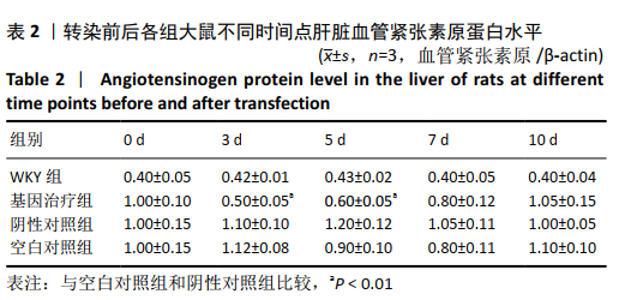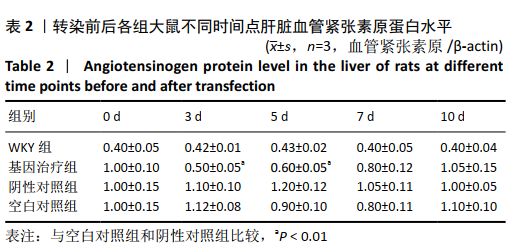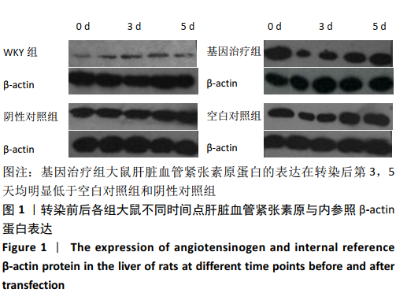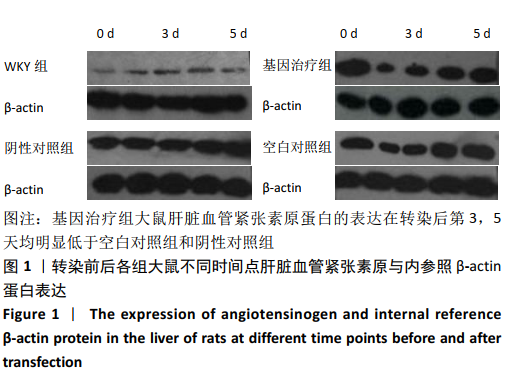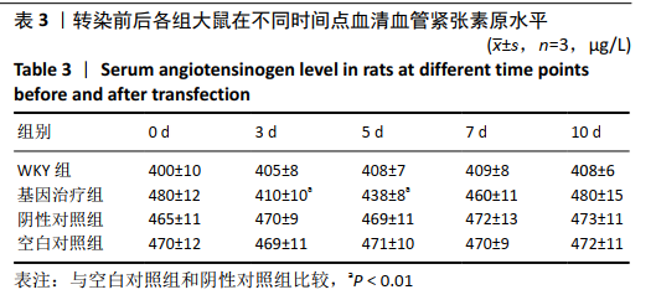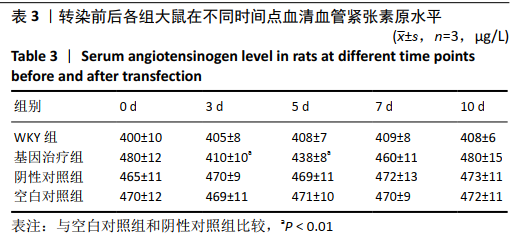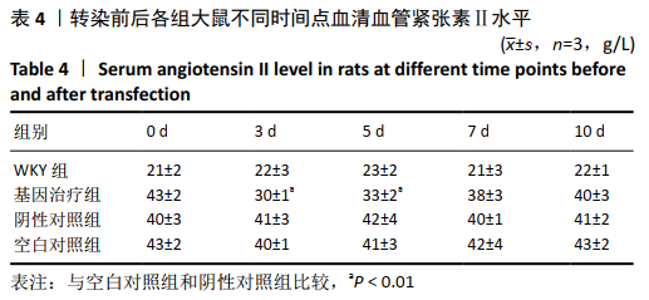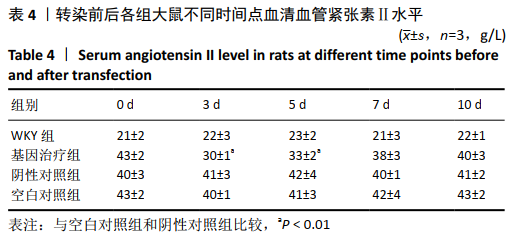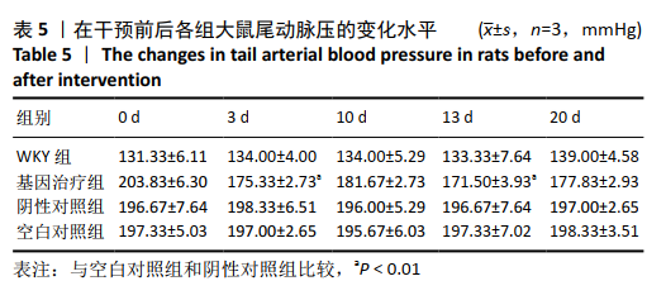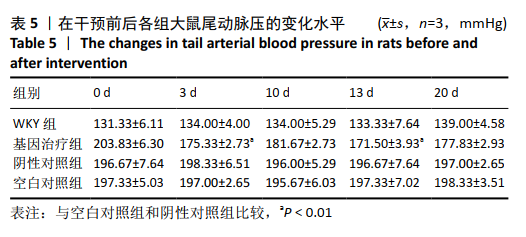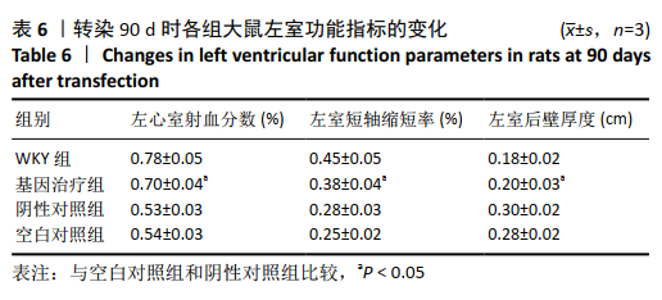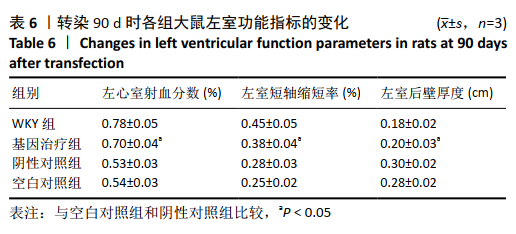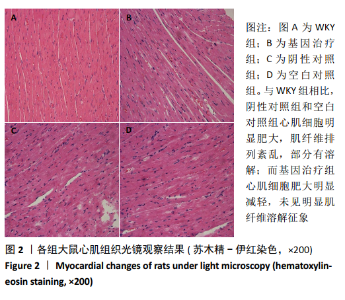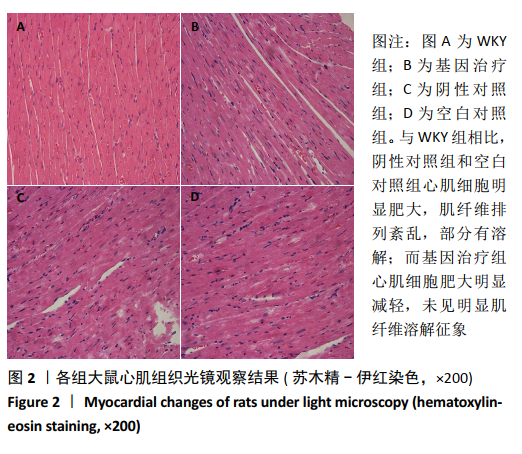Chinese Journal of Tissue Engineering Research ›› 2021, Vol. 25 ›› Issue (35): 5626-5631.doi: 10.12307/2021.291
Previous Articles Next Articles
Effect of angiotensinogen-targeted RNA interference in spontaneously hypertensive rats
Yuan Lifen1, Cao Shuang2, Sun Ting3
- 1Department of Respiratory Medicine and Critical Care Medicine, 2Department of Anesthesiology, 3Department of Cardiovascular Medicine, Shanghai Ninth People’s Hospital, Shanghai Jiaotong University School of Medicine, Shanghai 200011, China
-
Received:2020-12-14Revised:2020-12-18Accepted:2021-01-30Online:2021-12-18Published:2021-08-03 -
Contact:Sun Ting, MD, Chief physician, Department of Cardiovascular Medicine, Shanghai Ninth People's Hospital, Shanghai Jiaotong University School of Medicine, Shanghai 200011, China -
About author:Yuan Lifen, Master, Attending physician, Department of Respiratory Medicine and Critical Care Medicine, Shanghai Ninth People’s Hospital, Shanghai Jiaotong University School of Medicine, Shanghai 200011, China -
Supported by:the National Natural Science Foundation of China (General Program), No. 81770505 (to ST)
CLC Number:
Cite this article
Yuan Lifen, Cao Shuang, Sun Ting. Effect of angiotensinogen-targeted RNA interference in spontaneously hypertensive rats[J]. Chinese Journal of Tissue Engineering Research, 2021, 25(35): 5626-5631.
share this article
Add to citation manager EndNote|Reference Manager|ProCite|BibTeX|RefWorks
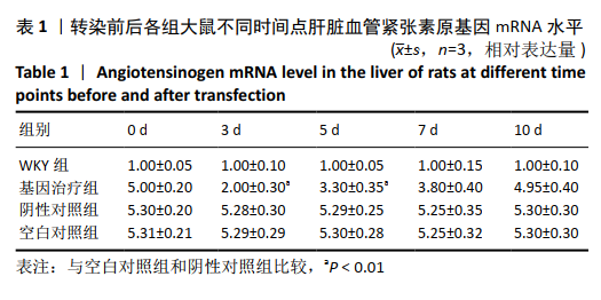
2.1 实验动物数量分析 实验选用高血压模型对照鼠(WKY)20只和自发性高血压大鼠(SHR)60只,实验过程无脱失,全部进入结果分析。 2.2 大鼠一般情况 实验期间每日观察实验动物,均未出现大鼠死亡、体温升高、食欲减退、体质量下降以及尿便异常等反应。 2.3 GPE-AGT shRNA纳米复合物转染对大鼠肝脏组织血管紧张素原mRNA的影响 Real-time PCR结果提示,基因治疗组大鼠肝脏血管紧张素原mRNA的表达水平在转染后第3,5天均明显低于空白对照组和阴性对照组(P < 0.01),在转染后第7,10天血管紧张素原mRNA的表达接近于空白对照组及阴性对照组,但始终高于WKY组。这说明自发性高血压大鼠在尾静脉注射GPE-AGT shRNA纳米复合物后,能够显著降低血管紧张素原mRNA的表达。见表1。"
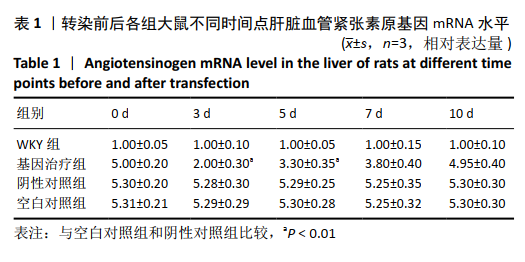
| [1] SARKI AM, NDUKA CU, STRANGES S, et al. Prevalence of hypertension in low-and middle-income countries:a systematic review and meta-analysis.Medicine(Baltimore). 2015;94(50):e1959. [2] CHEN X, BARYWANI SB, HANSSON PO, et al. High-normal blood pressure conferred higher risk of cardiovascular disease in a random population sample of 50-year-old men: A 21-year follow-up. Medicine Baltimore. 2020;99(17):e19895. [3] REDDY ST, SAVITZ SI. Hypertension-Related Cerebral Microbleeds.Case Rep Neurol. 2020;12(3):266-269. [4] LEVY-VARADI R, YAGIL Y. Hypertension as a cause of renal disease - fact or fiction?. Harefuah. 2020;159(12):887-891. [5] SHEPPARD JP, BURT J, LOWN M, et al. Effect of Antihypertensive Medication Reduction vs Usual Care on Short-term Blood Pressure Control in Patients With Hypertension Aged 80 Years and Older: The OPTIMISE Randomized Clinical Trial. 2020;323(20):2039-2051. [6] FLACK JM, ADEKOLA B. Blood pressure and the new ACC/AHA hypertension guidelines. Trends Cardiovasc Med. 2020;30(3):160-164. [7] MESSERLI FH, BANGALORE S, BAVISHI C,et al. Angiotensin-Converting Enzyme Inhibitors in Hypertension: To Use or Not to Use?. J Am Coll Cardiol. 2018;71(13):1474-1482. [8] FALHAMMAR H, SKOV J, CALISSENDORFF J, et al. Associations Between Antihypertensive Medications and Severe Hyponatremia: A Swedish Population-Based Case-Control Study. J Clin Endocrinol Metab. 2020;105(10):dgaa194. [9] REN L, COLAFELLA KMM, BOVÉE DM, et al.Targeting angiotensinogen with RNA-based therapeutics.Curr Opin Nephrol Hypertens. 2020;29(2):180-189. [10] WU CH, WANG Y, MA M, et al.Antisense oligonucleotides targeting angiotensinogen: insights from animal studies. Biosci Rep. 2019;39(1): BSR20180201. [11] LI XC, ZHANG J, ZHUO JL. The vasoprotective Axes of the Renin-Angiotensin System: Physiological Relevance and Therapeutic Implications in Cardiovascular, Hypertensive and Kidney Diseases. Pharmacol Res. 2017; 125(Pt A):21-38. [12] LU H, CASSIS LA, KOOI CW,et al. Structure and Functions of Angiotensinogen.Hypertens Res. 2016;39(7):492-500. [13] TIRYAKI O, USALAN C, TARAKCIOGLU M. Urinary angiotensinogen level is correlated with blood pressure level and proteinuria in patients with masked hypertension. Clin Exp Hypertens. 2018;40(7):644-649. [14] TAKIMOTO-OHNISHI E, MURAKAMI K. Renin-angiotensin system research: from molecules to the whole body. J Physiol Sci. 2019;69(4):581-587. [15] WANG X, YE Y, GONG H, et al. The effects of different angiotensin II type 1 receptor blockers on the regulation of the ACE-AngII-AT1 and ACE2-Ang(1-7)-Mas axes in pressure overload-induced cardiac remodeling in male mice.J Mol Cell Cardiol. 2016;97:180-190. [16] HAN H. RNA Interference to Knock Down Gene Expression. Methods Mol Biol. 2018;1706:293-302. [17] BOBBIN ML, ROSSI JJ. RNA Interference (RNAi)-Based Therapeutics: Delivering on the Promise?. Annu Rev Pharmacol Toxicol. 2016;56:103-122. [18] WANG Y, SU J, CAI W, et al. Hepatocyte-targeting Gene Transfer Mediated by Galactosylated Poly(ethyleneGlycol)-Graft-Polyethylenimine Derivative. Drug Des Devel Ther. 2017;7:211-221. [19] 董幸,潘燕,孟延.尾套法与颈动脉法测量大鼠血压的相关性研究[J]. 实验室研究与探索,2008,27(5):53-55. [20] 葛均波,徐永健,王辰.内科学[M].北京:人民卫生出版社,2019:247. [21] JUDD E, CALHOUN DA. Apparent and true resistant hypertension: definition, prevalence and outcomes. J Hum Hypertens. 2014;28(8):463-468. [22] WANG Y, ZHAO D, WEI X, et al. PEGylated Polyethylenimine Derivative-Mediated Local Delivery of the shSmad3 Inhibits Intimal Thickening after Vascular Injury. Biomed Res Int. 2019 29;2019:8483765. [23] TIRYAKI O, USALAN C, TARAKCIOGLU M. Urinary angiotensinogen level is correlated with blood pressure level and proteinuria in patients with masked hypertension. Clin Exp Hypertens. 2018;40(7):644-649. [24] SHAO W, MIYATA K, KATSURADA A, et al. Increased angiotensinogen expression, urinary angiotensinogen excretion, and tissue injury in nonclipped kidneys of two-kidney, one-clip hypertensive rats. Am J Physiol Renal Physiol. 2016;311(2):F278-290. [25] AGASSANDIAN K, GROBE JL, LIU X, et al. Evidence for intraventricular secretion of angiotensinogen and angiotensin by the subfornical organ using transgenic mice. Am J Physiol Regul Integr Comp Physiol. 2017;312(6): R973-R981. [26] HARA T, YAMAMURA T, MURAKAMI-ASAHINA M, et al. Development of a novel murine heart failure model overexpressing human renin and angiotensinogen. FEBS Open Bio. 2020;10(5):718-725. [27] REICHHART N, HAASE N, CRESPO-GARCIA S, et al. Hypertensive retinopathy in a transgenic angiotensin-based model. Clin Sci (Lond). 2016;130(13):1075-1088. [28] KWIECINSKI J, LENNEN RJ, GRAY GA, et al. Progression and regression of left ventricular hypertrophy and myocardial fibrosis in a mouse model of hypertension and concomitant cardiomyopathy. J Cardiovasc Magn Reson. 2020;22(1):57. [29] ZHOU Y, YUAN J, WANG Y, et al. Plasma metanephrins are associated with myocardial hypertrophy and cardiac diastolic function in patients with essential hypertension. Clin Invest Med. 2020;43(1):E22-E29. [30] NWABUO CC, VASAN RS. Pathophysiology of Hypertensive Heart Disease: Beyond Left Ventricular Hypertrophy. Curr Hypertens Rep. 2020;22(2):11. [31] SANIDAS E, MALLIARAS K, PAPADOPOULOS D, et al. Antihypertensive therapy and sudden cardiac death, should we expect the unexpected?. J Hum Hypertens. 2020;34(5):339-345. [32] CRUZ RODRIGUEZ JB, ALKHATEEB H. Beta-Blockers, Calcium Channel Blockers, and Mortality in Stable Coronary Artery Disease. Curr Cardiol Rep. 2020;22(3):12. [33] MESSERLI FH, OPARIL S, FENG Z. Comparison of efficacy and side effects of combination therapy of angiotensin-converting enzyme inhibitor (benazepril) with calcium antagonist (either nifedipine or amlodipine) versus high-dose calcium antagonist monotherapy for systemic hypertension. Am J Cardiol. 2000;86(11):1182-1187. [34] LI WX, BIAN YC, REN JJ, et al. Male infertility - related gene knockout mouse models. Zhonghua Nan Ke Xue. 2020;26(4):357-363. [35] GHEIBI-HAYAT SM, JAMIALAHMADI K. Antisense Oligonucleotide (AS-ODN) Technology: Principle, Mechanism and Challenges. Biotechnol Appl Biochem. 2020 Sep 16. doi: 10.1002/bab.2028. [36] TERMOLINO P. RNA Interference (RNAi) in Tomato Crop Research. Methods Mol Biol. 2021;2264:163-175. [37] EDHOLM ES, ROBERT J. RNAi-Mediated Loss of Function of Xenopus Immune Genes by Transgenesis. Cold Spring Harb Protoc. 2018;2018(7). doi: 10.1101/pdb.prot101519. [38] RAJAM MV. RNA silencing technology: A boon for crop improvement. J Biosci. 2020;45:118. [39] 秦川.医学实验动物学[M].北京:人民卫生出版社,2018:121. |
| [1] | Wang Weikang, Liu Xiaodong, Zhou Changlin, Tian Jun. Regulatory role of microRNAs in the occurrence and development of osteoarthritis [J]. Chinese Journal of Tissue Engineering Research, 2021, 25(35): 5709-5715. |
| [2] | Li Songtao, Li Xinyi, Song Yunfeng, Ning Jiayin, Ren Qiang, Yang Renxu, Peng Bo. Maxing Xiongting Mixture regulates factors relevant to lung reshaping and vascular remodeling of hypoxic pulmonary hypertension rats [J]. Chinese Journal of Tissue Engineering Research, 2021, 25(2): 274-280. |
| [3] | Ma Dujun, Peng Liping, Chen Feng, Jiang Shunwan, Jiang Jinting, Gao Kun, Lin Zhanpeng. Research strategy of gene editing technology in the gene treatment of osteoarthritis [J]. Chinese Journal of Tissue Engineering Research, 2021, 25(2): 298-303. |
| [4] | Chen Xinling, Wang Shenglan. Cell autophagy, pathway, regulation and its multiple correlations with pulmonary hypertension [J]. Chinese Journal of Tissue Engineering Research, 2021, 25(2): 311-316. |
| [5] | Ye Quanying, Chen Qisheng, Li Yanwen, Wang Ting, Chen Xiaoyan, Yue Yun. Effect of cassia seed aqueous extract on blood pressure level in N-nitro-L-arginine-methyl ester induced hypertensive rats [J]. Chinese Journal of Tissue Engineering Research, 2021, 25(11): 1705-1711. |
| [6] | Hu Zhongling, Li Binbin, Cui Yishuang, Wang Qian, Zhang Hui, Li Qijia, Wang Zhiqiang. Concept, mechanism and problem of gene therapy for osteoarthritis [J]. Chinese Journal of Tissue Engineering Research, 2020, 24(27): 4356-4363. |
| [7] | Yuan Guoqiang, Qin Yongsheng, Peng Peng. High-intensity interval training for treating pathological cardiac hypertrophy in spontaneously hypertensive rats: effects and mechanisms [J]. Chinese Journal of Tissue Engineering Research, 2020, 24(23): 3708-3715. |
| [8] | Zhang Yingying, Wang Yinglei, Meng Lin, Xiao Lin, Li Zhonghai, Zhao Zhankui, Wu Houke. RNA interferes with Id2 gene expression to inhibit proliferation and invasion of PC-3 prostate cancer stem cells [J]. Chinese Journal of Tissue Engineering Research, 2019, 23(9): 1342-1348. |
| [9] | Zhang Chaohui, Zhao Feng, Feng Yunpeng, Wang Wenbin, Kuang Baoping, Huang He. Research progress and medical application of modeling and simulation of cardiovascular system [J]. Chinese Journal of Tissue Engineering Research, 2019, 23(7): 1115-1121. |
| [10] | Chen Qingui, Zeng Mian, He Wanmei, Zhang Lishan, Zheng Haichong. Knockdown of foxM1 strengthens osteogenic differentiation ability of bone marrow mesenchymal stem cells [J]. Chinese Journal of Tissue Engineering Research, 2019, 23(5): 673-679. |
| [11] | Lin Min, Wei Weili, He Yimi, Chen Zhikui. Construction of a gene-loaded multifunctional polymer microbubble targeting breast cancer cells [J]. Chinese Journal of Tissue Engineering Research, 2019, 23(34): 5468-5472. |
| [12] | Yu Chengqiang, Zhang Yu, Xie Chengxin, Ou Yufu, Wei Jianxun. Molecular biological mechanism of intervertebral disc degeneration and the advantages and prospects of regenerative therapy [J]. Chinese Journal of Tissue Engineering Research, 2019, 23(30): 4889-4896. |
| [13] | Yan Jinyu, Xing Wanhong. Lentiviral-mediated shRNA silencing of Notch-1 inhibits expression of Notch signaling pathway in rat bone marrow mesenchymal stem cells [J]. Chinese Journal of Tissue Engineering Research, 2019, 23(17): 2659-2664. |
| [14] | Cheng Haiyan, Long Heming, Xie Xiaoying, Li Feng. ciRS-7 regulates the stemness of cervical cancer stem cells: effects and mechanisms [J]. Chinese Journal of Tissue Engineering Research, 2019, 23(13): 2009-2015. |
| [15] | Zhou Xiao-xiong, Wei Wei-chao, Sun Ce, Ye Tao-chun, Wang Song, Qing Li-jin, Wu Hui, Xian Shao-xiang. Transplantation of lentiviral-transfected endothelial progenitor cells for pulmonary hypertension and the interventional effect of astragalosides [J]. Chinese Journal of Tissue Engineering Research, 2018, 22(9): 1425-1431. |
| Viewed | ||||||
|
Full text |
|
|||||
|
Abstract |
|
|||||
